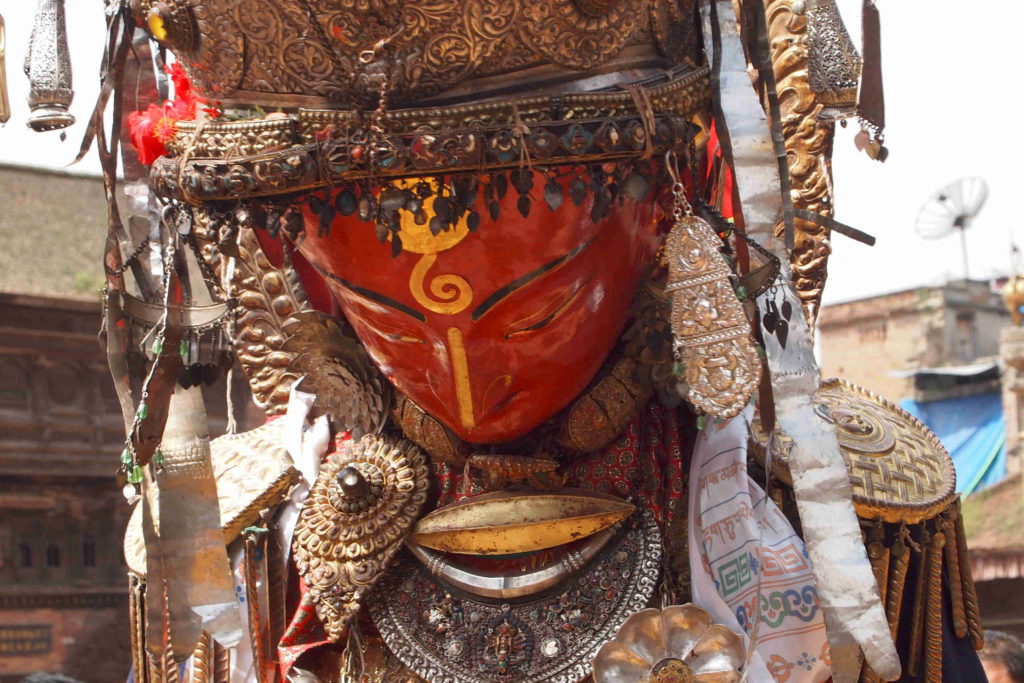Andrea Wollein. 2017. ‘An ethnographic study of the Mūl Dīpaṅkara shrine in Bhaktapur (Nepal): the relationship between people and place’. University of Vienna: M.A. thesis (Masterstudium Kultur u. Gesellschaft des neuzeitlichen Südasiens). 189 pp., 87 figures. URN: nbn:at:at-ubw:1-20536.38953.228466-1 [official notice] [author: facebook]

Abstract: This thesis presents locality specific research in the form of an ethnography that draws both from fieldwork and published scholarly literature. The inter-disciplinary research is contextualized within the wider field of South Asian Studies and pertains to Himalayan, Buddhist and Newar Studies as well as to Tibetology. It is specifically concerned with the socioreligious dimension of Newar Buddhist monasteries (Skrt. vihāra, New. bāhā and bahī), the Buddhist deity Dīpaṅkara and the configuration of the relationship between the two of them as found in the setting of the Mūl Dīpaṅkara shrine in Bhaktapur. Since there has been no previous detailed investigation of this shrine, the thesis shows how it brings to bear vital importance in Newar Buddhism and why it is regarded as center of Newar Buddhism in Bhaktapur. After establishing the context, the place, its people and the associated activities are successively introduced based on new research. Apart from a description of the shrine’s spatial aspects and its history, the various actors are discussed, highlighting the crucial role which the site plays both for residents and pilgrims. The shrine’s unique authority structures are analyzed and a sociodemographic survey of regular visitors, along with detailed information about Tibetan pilgrims is provided. Lastly, the periodic activities related to the site are explored, with a particular focus on the Pañcadān festival of 2016.
Kurzzusammenfassung
Die vorliegende Arbeit ist eine ethnographische Studie des Mūl Dīpaṅkara Schreines in Bhaktapur, die sich sowohl auf Feldforschung als auch auf wissenschaftliche Literatur bezieht. Die interdisziplinäre Untersuchung ist angesiedelt im Bereich der Südasienkunde und sowohl relevant für Studien des Himalaya-Raumes und der Kultur der Newar, sowie für das Feld der Tibetologie und Buddhismuskunde. Die Arbeit beschäftigt sich im Speziellen mit der sozioreligiösen Dimension von buddhistischen Klöstern der Newar (Skrt. vihāra, New. bāhā and bahī) und der buddhistischen Gottheit Dīpaṅkara. Die Beziehung der beiden untereinander ist das Kernthema der vorliegenden Arbeit, das an Hand der Fallstudie des Mūl Dīpaṅkara Schreines in Bhaktapur herausgearbeitet wird.
Da es bisher noch keine detaillierte Untersuchung dieses Schreines gab, stellt diese Arbeit den Schrein erstmals als Zentrum des Newar Buddhismus in Bhaktapur vor und erörtert die Gründe, warum dem Ort eine wesentliche Bedeutung zukommt. Nach einer allgemeinen und modularen Einführung in den breiteren Kontext, werden der Untersuchungsort und die lokalen Akteure, mitsamt ihren rituellen Aktivitäten, nacheinander und auf Basis der durchgeführten Feldforschung vorgestellt. Neben einer Beschreibung der räumlichen Aspekte und Geschichte des Schreines, werden die unterschiedlichen Akteure eingehend betrachtet und es wird gezeigt, dass der Schrein nicht nur für die lokale Bevölkerung ein religiöser Anziehungspunkt ist, sondern auch für tibetische Pilger. Die interne Organisationsstruktur des Scheines und die einzigartigen Elemente der vorgefundenen Hierarchie werden analysiert. Darüber hinaus bietet eine soziodemographische Studie qualitative sowie quantitative Einblicke in die Besucherstruktur des Schreines und auch die tibetischen Pilger werden individuell vorgestellt. Der letzte Teil der Arbeit widmet sich einer Dokumentation der periodisch auftretenden, örtlichen Rituale und Aktivitäten, mit einem besonderen Fokus auf das Pañcadān Fest aus dem Jahr 2016.
Contents
Acknowledgements … 5
List of figures … 7
Transliteration systems … 11
Dates … 11
1 Introduction … 12
1.1 Theory and methodology … 18
1.2 Chapter outline … 22
Part I — Establishing the context
2 The Newars … 25
2.1 Double-headed caste system … 31
2.1.1 Śivamārgī and Buddhamārgī … 35
2.2 Guthi … 37
2.2.1 The Buddhist monastery and the guthi.. 40
3 Newar Buddhism … 43
3.1 Householder monks and priests. 48
3.2 Bāhā and bahī … 51
3.3 Relation to Tibetan Buddhism … 57
3.4 Controversies. 60
4 Dīpaṅkara Buddha … 66
4.1 Relevance in the Kathmandu Valley … 67
4.1.1 Related festivals … 72
5 Bhaktapur … 79
5.1 Urban layout, spatial categories and local deities … 83
5.2 The five Dīpaṅkara Buddhas … 88
5.3 References in Tibetan pilgrimage literature … 95
Part II — Exploring the Mūl Dīpaṅkara shrine in Bhaktapur
6 The place … 102
6.1 Mūl Dīpaṅkara shrine … 108
6.1.1 Mūl Dīpaṅkara image … 119
7 The people … 124
7.1 Mūl Dīpaṅkara Guthi … 125
7.2 Lay community … 132
7.3 Tibetan pilgrims … 138
8 The activities … 142
8.1 Example A: Yenyā punhi … 146
8.2 Example B: Vasudhārā vrata … 151
8.3 Example C: Pañcadān … 155
9 Conclusions … 171
Bibliography … 175
Kurzzusammenfassung … 187
Abstract … 188

